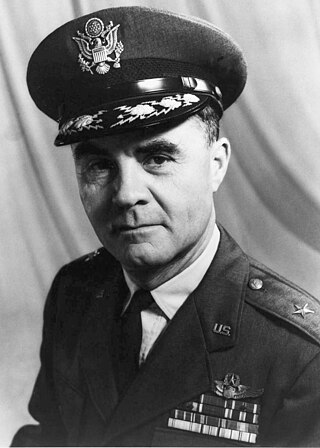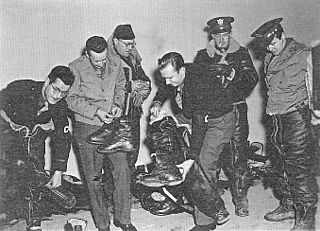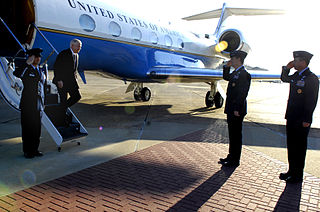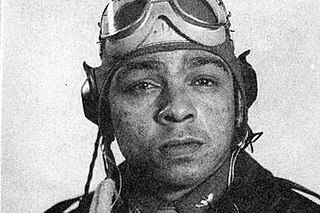
Martin Ludwig Bormann was a German Nazi Party official and head of the Nazi Party Chancellery. He gained immense power by using his position as Adolf Hitler's private secretary to control the flow of information and access to Hitler. He used his position to create an extensive bureaucracy and involve himself as much as possible in the decision making.

Paul Warfield Tibbets Jr. was a brigadier general in the United States Air Force. He is best known as the aircraft captain who flew the B-29 Superfortress known as the Enola Gay when it dropped a Little Boy, the first of two atomic bombs used in warfare, on the Japanese city of Hiroshima.
ODESSA is an American codename coined in 1946 to cover Nazi underground escape-plans made at the end of World War II by a group of SS officers with the aim of facilitating secret escape routes, and any directly ensuing arrangements. The concept of the existence of an actual ODESSA organisation has circulated widely in fictional spy novels and movies, including Frederick Forsyth's best-selling 1972 thriller The Odessa File. The escape-routes have become known as "ratlines". Known goals of elements within the SS included allowing SS members to escape to Argentina or to the Middle East under false passports.

The Party Chancellery, was the name of the head office for the German Nazi Party (NSDAP), designated as such on 12 May 1941. The office existed previously as the Staff of the Deputy Führer but was renamed after Rudolf Hess flew to Scotland in an attempt to negotiate a peace agreement without Adolf Hitler's authorization. Hess was denounced by Hitler, his former office was dissolved, and the new Party Chancellery was formed in its place under Hess' former deputy, Martin Bormann.

The Women Airforce Service Pilots (WASP) was a civilian women pilots' organization, whose members were United States federal civil service employees. Members of WASP became trained pilots who tested aircraft, ferried aircraft, and trained other pilots. Their purpose was to free male pilots for combat roles during World War II. Despite various members of the armed forces being involved in the creation of the program, the WASP and its members had no military standing.

Royal Air Force Polebrook or more simply RAF Polebrook is a former Royal Air Force station located 3.5 miles (5.6 km) east-south-east of Oundle, at Polebrook, Northamptonshire, England. The airfield was built on Rothschild estate land starting in August 1940.

Royal Air Force Bovingdon or more simply RAF Bovingdon is a former Royal Air Force station located near the village of Bovingdon, Hertfordshire, England, about 2.5 miles (4.0 km) south-west of Hemel Hempstead and 2.5 miles (4.0 km) south-east of Berkhamsted.

The combat box was a tactical formation used by heavy (strategic) bombers of the U.S. Army Air Forces during World War II. The combat box was also referred to as a "staggered formation". Its defensive purpose was in massing the firepower of the bombers' guns, while offensively it concentrated the release of bombs on a target.
Homer William Bigart was an American reporter who worked for the New York Herald Tribune from 1929 to 1955 and for The New York Times from 1955 to his retirement in 1972. He was considered a "reporter's reporter" and an "enduring role model." He won two Pulitzer Prizes as a war correspondent, as well as most of the other major journalism awards.
Robert Perkins Post worked as a reporter for the New York Times during World War II. He was part of a group of eight reporters, known as the Legion of the Doomed or the Writing 69th, selected to fly bomber missions with United States Eighth Air Force.
William Warren Wade was an American war correspondent during World War II. He was a member of an eight-man team of journalists who flew bombing missions over Germany with the U.S. Air Force while he was working for the International News Service.

The Writing 69th was a group of eight American journalists who trained to fly bomber missions over Germany with the U.S. Eighth Air Force during World War II.
Gladwin Hill was an American journalist who was a member of the famed Writing 69th, a group of reporters who trained and flew on bombing missions with the Eighth Air Force.

The 42nd Air Base Wing is a United States Air Force unit assigned to Air University of Air Education and Training Command. It is stationed at Maxwell-Gunter Air Force Base, Alabama and is the host unit for Maxwell-Gunter. The wing's primary mission is to support all activities of Air University, the 908th Airlift Wing and other tenant units stationed at Maxwell-Gunter.

The 38th Bombardment Group is an inactive unit of the United States Air Force. It was most recently assigned as the operational (flying) component of the 38th Bombardment Wing, stationed at Laon-Couvron Air Base, France, where it was inactivated on 8 December 1957.

The 30th Tactical Missile Squadron is an inactive United States Air Force unit. In 1985 the squadron was formed by combining three United States Air Force and Army Air Forces units that had served in World War II and the Cold War into a single unit with a common heritage. However, the combined unit has not since been active.

Walter P. Manning (POW) † was an American fighter pilot of the primarily African American Tuskegee Airmen. He flew 50 missions, and was awarded the Air Medal for heroism six times. After being shot down in 1945, he was captured in Austria and subsequently lynched by a mob. He was posthumously awarded the Congressional Gold Medal in 2007 along with all other Tuskegee Airmen. Manning is the only known black man to have been lynched in Austria during World War II.

Lawrence Dickson † was an American pilot and a member of the famed group of the World War II-era Tuskegee Airmen. Dickson flew 68 mission in World War II before he was forced to eject from his aircraft over Austria in 1944. Dickson was declared missing in action. On July 27, 2018, Dickson's remains were identified by the Defense POW/MIA Accounting Agency.

Flight Officer William Armstrong was a member of the famed group of World War II-era African-Americans known as the Tuskegee Airmen. His plane was shot down on Easter Sunday in 1945 over Austria. In 2018 he was inducted into the Rhode Island Aviation Hall of Fame.

Everett Ernest Blakely was a career officer of the United States Air Force. He was a highly decorated B-17 pilot with the “Bloody Hundredth” Bombardment Group of the 8th Air Force in Europe during World War II. He received eleven medals for his service including the Silver Star for “gallantry in action”, the Distinguished Flying Cross for “heroism or extraordinary achievement during aerial flight” and the Air Medal with 4 oak leaf clusters. Blakely and the crew of his plane “Just A Snappin” long held the record for the most enemy aircraft shot down on a single mission. The crew of Just A Snappin was credited with 9 enemy aircraft shot down. He also received his Pilot Wings with 3 stars from the Colombian Air Force.














